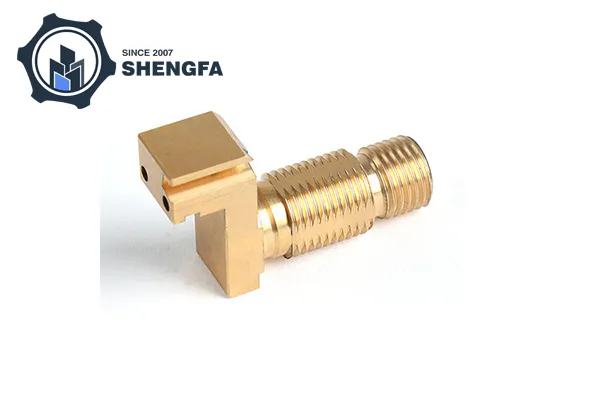Everything You Need to Know About Brass CNC Machining Services
2024-10-22
Brass CNC machining is widely used in various industries for creating precise components with excellent mechanical and electrical properties. This blog answers the most frequently asked questions about brass CNC machining services to help you understand its benefits, applications, and key considerations.
1. What is Brass CNC Machining?
Brass CNC machining refers to the use of Computer Numerical Control (CNC) machines to manufacture custom parts and components from brass material. CNC machines are highly automated, following digital designs to cut, shape, and finish brass with extreme precision.
Brass is a popular choice for machining because of its:
Malleability: Easy to shape without breaking
Corrosion resistance: Ideal for environments prone to moisture
Electrical conductivity: Used in electrical components
2. What are the benefits of CNC machining brass?
Brass offers several advantages that make it ideal for CNC machining:
High Precision: CNC machining ensures consistent accuracy for complex geometries.
Corrosion Resistance: Brass components withstand harsh environments and do not rust.
Excellent Electrical Conductivity: Used in connectors, terminals, and other electronic components.
Low Friction: Brass parts perform well in moving systems, such as gears and valves.
Aesthetic Appeal: Brass parts have a golden appearance, suitable for decorative applications.
3. What industries use brass CNC machining services?
Brass components manufactured using CNC machining are essential in many industries:
Electronics: Terminals, connectors, and sensors
Plumbing: Fittings, valves, and adapters
Automotive: Gears, bushings, and fuel connectors
Aerospace: Precision parts for aircraft systems
Medical: Components for surgical tools and devices
Luxury Goods: Watches, jewelry, and decorative fixtures
4. What types of brass alloys are used in CNC machining?
Various brass alloys are used depending on the application requirements:
C360 Brass (Free-machining Brass): Ideal for high-precision parts with excellent machinability.
C260 Brass (Cartridge Brass): Known for strength and flexibility, often used in electronics.
C280 Brass (Muntz Metal): Strong and corrosion-resistant, making it suitable for marine applications.
C385 Brass: Used for architectural applications due to its aesthetic appearance.
5. How does the CNC machining process work for brass?
Brass CNC machining involves multiple steps to create a finished product:
1. Design: A digital 3D model of the part is created using CAD software.
2. Programming: The design is converted into G-code (machine instructions).
3. Machining: The CNC machine removes material from a brass workpiece using cutting tools to match the design.
4. Finishing: Polishing, deburring, or plating may be applied for smooth surfaces and improved durability.
5. Quality Inspection: The finished part undergoes dimensional and quality checks to meet customer requirements.
6. What types of CNC machines are used for machining brass?
Various CNC machines can process brass, including:
CNC Milling Machines: Used to create complex shapes, pockets, and slots.
CNC Turning Machines: Ideal for cylindrical parts such as bushings and connectors.
Swiss CNC Machines: Perfect for small, intricate components like screws and electronic connectors.
Multi-axis CNC Machines: Enable the creation of complex geometries with fewer setups.
7. What are the challenges of CNC machining brass?
While brass is relatively easy to machine, there are a few challenges:
Chip Control: Brass can produce sharp chips that may damage tools or affect surface quality.
Tool Wear: Brass machining requires tools with good wear resistance to maintain accuracy.
Workpiece Heating: Cutting brass at high speeds can generate heat, which may affect part dimensions.
Precision Requirements: Achieving tight tolerances demands well-calibrated machines and experienced operators.
9. What factors affect the cost of brass CNC machining services?
Several factors determine the cost of CNC machining brass parts:
Complexity of the design: Intricate parts require more machining time.
Material costs: Brass prices can vary based on the alloy and market conditions.
Production volume: Larger orders often qualify for discounts.
Finishing requirements: Polishing, plating, or coating increases the total cost.
Lead time: Rush orders may incur additional fees.
10. How can I choose the right brass CNC machining service provider?
Here are some tips for selecting a reliable machining service:
Experience with brass machining: Ensure the provider has experience working with brass alloys.
Advanced equipment: Look for a provider with modern CNC machines and multi-axis capabilities.
Customization options: Choose a provider that offers finishing and quality inspection services.
Proven track record: Check for customer reviews or case studies.
Technical support: Ensure they offer after-sales service and technical support.
11. How can brass CNC machining benefit my business?
Using brass CNC machining services can help businesses in several ways:
Improved product quality: Precision machining ensures parts meet tight tolerances.
Faster prototyping: Quickly turn ideas into reality with rapid CNC prototyping.
Customization: Tailor components to meet unique requirements.
Cost-efficiency: Minimize material waste and reduce manual labor.
Conclusion
Brass CNC machining services are essential for industries that require precision components with excellent electrical, mechanical, and aesthetic properties. Whether you're in the automotive, electronics, or plumbing industry, CNC machining offers the accuracy and versatility needed to create high-quality parts.
By selecting the right alloy, provider, and design approach, businesses can fully leverage the benefits of brass CNC machining for custom parts and large production runs alike.



